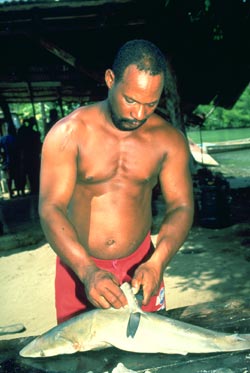
|
|
|
|
|
|
Shark Info (06-15-2001) |
Author |
|
Intro: |
Shark Info |
|
Main article: |
Shark Info |
|
Article 1: |
Fishing, fins and the lack of sufficient international controls |
Shark Info |
Article 2: |
Shark Info |
|
Article 3: |
Dr. E. K. Ritter |
|
Fact Sheet: |
Dr. E. K. Ritter |
|
The decline of traditional shark fishingReport by Shark Info Statistics from the FAO (Food and Agriculture Organization) show that
approximately 800,000 tons of sharks are caught and killed worldwide
annually. Only a handful of countries are mainly responsible for this
massacre - such as the U.S., India or Taiwan - but these countries fish
more than 9,000 tons per year and wherever their fishing fleets appear
on the horizon, they leave behind nothing except desolation and empty
seas.
Mexiko: Traditional fishery delivers 80% of Mexico's total catch. More
than this, most fishermen not only depend on the sale of fish, their
main source of food is shark meat. According to a report from WildAid,
this is a problem which not only affects Mexican fishermen but other
countries as well.
The oceans surrounding India are not only plundered by foreign fleets but also by India's own fleet. In Chennai (Madras) alone two dozen companies export shark fins mainly to Asian regions such as Hong Kong, Taiwan and Singapore. But even these traders see their existence threatened by the constant decrease in shark catches. In an interview with WildAid one dealer - who processes mainly blacktip sharks (Carcharhinus limbatus) and hammerheads (Sphyrna species) - reported that not too long ago he could collect three tons of shark fins on one sole trip to twelve local shark fishing villages, while today he has to make about 300 trips for the same amount. Astonishingly enough, while traditional fishery is about to collapse, the Indian governmental authorities established a program for the proper industrial processing of shark fins back in 1997 in order to compete better internationally. India is the largest shark fishing nation of the world, landing more than 130,000 tons annually or 16% of worldwide catches. The Indian Government does not require the individual shipping companies to provide catch number statistics, nor does it have any plans to sustainably manage shark populations in its territorial waters. Kenya: Traditional Mexican and Indian fishermen are not the only ones affected by decreasing shark populations. The end of traditional fisheries is inevitable and many people will have to tighten their belts even more. This is the case in Ngomeni, a fishing village in northern Kenya where up until recently one night's catch sufficed to nourish an entire village, with enough shark meat left over to sell to other villages. After the longliners and trawlers pillaged the area in July 1999, one catch was not even enough to supply the village itself. At least 20 trawlers were sighted in the immediate area of Ngomeni, equipped with fishing nets with a mesh size of 3 to 5 cm which is enough to just about totally clear an entire region of fish. By comparison, the fishermen of Ngomeni use a mesh size of 20 to 23 cm. One fisherman stated that in the mid-eighties he could sell approximately 150 kg of shark meat on a daily basis, while in the mid-nineties it was not more than 2 kg per day. The Kenyan Government did not sit back idly but passed a law forbidding foreign trawlers from fishing in a five-mile zone off the coast, while for longliners the limit was set at 200 miles. Unfortunately, the fishing fleets did not appear to heed this law, all the more because the Kenyan Government lacks both money and personnel to efficiently control their territorial waters and to punish transgressors. Witnesses report that during the very sporadic controls the fishermen in the trawlers trick the controllers by showing them large-meshed nets. When actually fishing they then switch back to their finely meshed nets. The same situation is encountered by another traditional fishing village in Kenya known as Malindi. Sharks and fish have to be brought in from Mombasa in order to guarantee the survival of the village. Congo: In the Congo a general provisional ban on shark fishing was passed in spring 2001. In a letter to industrial companies and traditional fishermen, Minister Djombo informed them of this ban and announced severe fines for anyone who ignored it. The state of the shark populations in the Congo is extremely alarming, especially due to the enormously growing interest of Asian countries in sharks fins. Several traditional fishermen are now thinking about giving up fishing completely, claiming that the fishing of another species such as sardines would not pay off. South Africa: Here most shark populations are probably already so strongly overfished that the number of individuals necessary to ensure population maintenance has sunk below the biologically required limit. This country is considered an important "finning" center. However, a confidential source revealed that any quantitative statistics from these regions must be treated skeptically because catch numbers are deliberately manipulated to evade customs duties and taxes. Each year South Africa hands out 85 licenses to Japanese longliners and 24 licenses to Taiwanese longliners, giving them the right to fish in their EEZ or "exclusive economic zone". Although these fishing trawlers must provide details of their catch in order to have their licenses renewed, official sources infer that the numbers given do not correspond with the real amounts.
Recognizing the threat to the many fish and shark populations worldwide,
the Food and Agricultural Organization (FAO) established a behavioral
code for the sustainable fishing of national fish populations. It
recommends affected countries to establish a management plan for
decimated shark populations in order to give them a chance to recover. May be published only by indicating the source: Shark Info |
|
|
|
|
|
|||||
